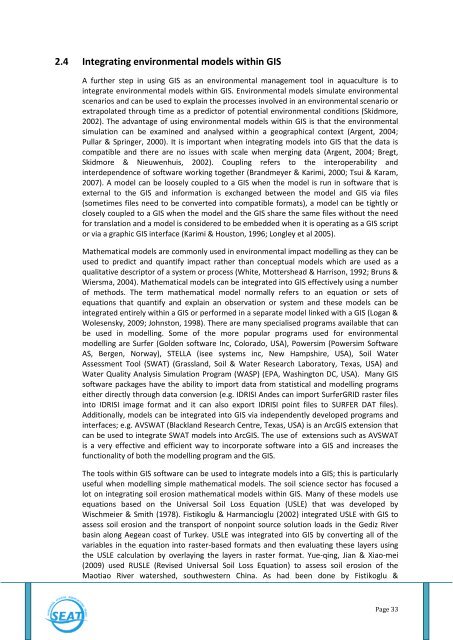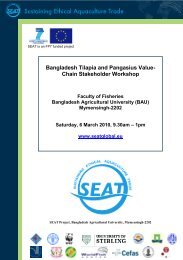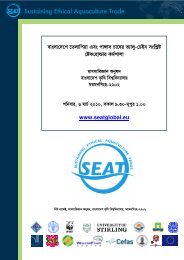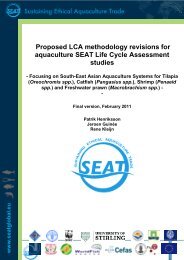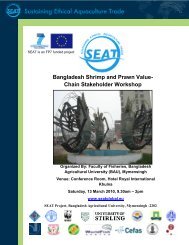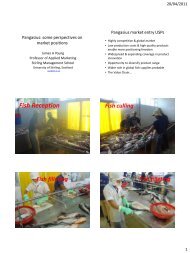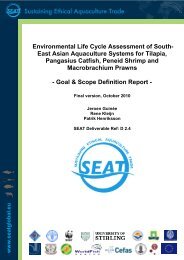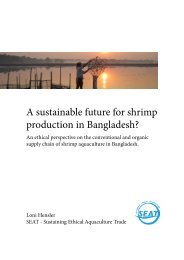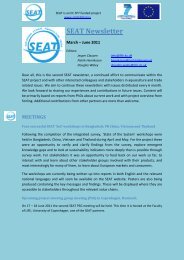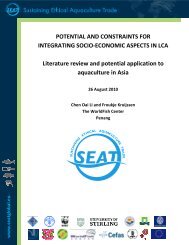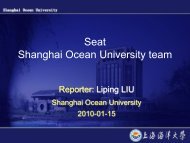D4.1 Review of Environmental Models - SEAT Global
D4.1 Review of Environmental Models - SEAT Global
D4.1 Review of Environmental Models - SEAT Global
You also want an ePaper? Increase the reach of your titles
YUMPU automatically turns print PDFs into web optimized ePapers that Google loves.
2.4 Integrating environmental models within GIS<br />
A further step in using GIS as an environmental management tool in aquaculture is to<br />
integrate environmental models within GIS. <strong>Environmental</strong> models simulate environmental<br />
scenarios and can be used to explain the processes involved in an environmental scenario or<br />
extrapolated through time as a predictor <strong>of</strong> potential environmental conditions (Skidmore,<br />
2002). The advantage <strong>of</strong> using environmental models within GIS is that the environmental<br />
simulation can be examined and analysed within a geographical context (Argent, 2004;<br />
Pullar & Springer, 2000). It is important when integrating models into GIS that the data is<br />
compatible and there are no issues with scale when merging data (Argent, 2004; Bregt,<br />
Skidmore & Nieuwenhuis, 2002). Coupling refers to the interoperability and<br />
interdependence <strong>of</strong> s<strong>of</strong>tware working together (Brandmeyer & Karimi, 2000; Tsui & Karam,<br />
2007). A model can be loosely coupled to a GIS when the model is run in s<strong>of</strong>tware that is<br />
external to the GIS and information is exchanged between the model and GIS via files<br />
(sometimes files need to be converted into compatible formats), a model can be tightly or<br />
closely coupled to a GIS when the model and the GIS share the same files without the need<br />
for translation and a model is considered to be embedded when it is operating as a GIS script<br />
or via a graphic GIS interface (Karimi & Houston, 1996; Longley et al 2005).<br />
Mathematical models are commonly used in environmental impact modelling as they can be<br />
used to predict and quantify impact rather than conceptual models which are used as a<br />
qualitative descriptor <strong>of</strong> a system or process (White, Mottershead & Harrison, 1992; Bruns &<br />
Wiersma, 2004). Mathematical models can be integrated into GIS effectively using a number<br />
<strong>of</strong> methods. The term mathematical model normally refers to an equation or sets <strong>of</strong><br />
equations that quantify and explain an observation or system and these models can be<br />
integrated entirely within a GIS or performed in a separate model linked with a GIS (Logan &<br />
Wolesensky, 2009; Johnston, 1998). There are many specialised programs available that can<br />
be used in modelling. Some <strong>of</strong> the more popular programs used for environmental<br />
modelling are Surfer (Golden s<strong>of</strong>tware Inc, Colorado, USA), Powersim (Powersim S<strong>of</strong>tware<br />
AS, Bergen, Norway), STELLA (isee systems inc, New Hampshire, USA), Soil Water<br />
Assessment Tool (SWAT) (Grassland, Soil & Water Research Laboratory, Texas, USA) and<br />
Water Quality Analysis Simulation Program (WASP) (EPA, Washington DC, USA). Many GIS<br />
s<strong>of</strong>tware packages have the ability to import data from statistical and modelling programs<br />
either directly through data conversion (e.g. IDRISI Andes can import SurferGRID raster files<br />
into IDRISI image format and it can also export IDRISI point files to SURFER DAT files).<br />
Additionally, models can be integrated into GIS via independently developed programs and<br />
interfaces; e.g. AVSWAT (Blackland Research Centre, Texas, USA) is an ArcGIS extension that<br />
can be used to integrate SWAT models into ArcGIS. The use <strong>of</strong> extensions such as AVSWAT<br />
is a very effective and efficient way to incorporate s<strong>of</strong>tware into a GIS and increases the<br />
functionality <strong>of</strong> both the modelling program and the GIS.<br />
The tools within GIS s<strong>of</strong>tware can be used to integrate models into a GIS; this is particularly<br />
useful when modelling simple mathematical models. The soil science sector has focused a<br />
lot on integrating soil erosion mathematical models within GIS. Many <strong>of</strong> these models use<br />
equations based on the Universal Soil Loss Equation (USLE) that was developed by<br />
Wischmeier & Smith (1978). Fistikoglu & Harmancioglu (2002) integrated USLE with GIS to<br />
assess soil erosion and the transport <strong>of</strong> nonpoint source solution loads in the Gediz River<br />
basin along Aegean coast <strong>of</strong> Turkey. USLE was integrated into GIS by converting all <strong>of</strong> the<br />
variables in the equation into raster-based formats and then evaluating these layers using<br />
the USLE calculation by overlaying the layers in raster format. Yue-qing, Jian & Xiao-mei<br />
(2009) used RUSLE (Revised Universal Soil Loss Equation) to assess soil erosion <strong>of</strong> the<br />
Maotiao River watershed, southwestern China. As had been done by Fistikoglu &<br />
Page 33


